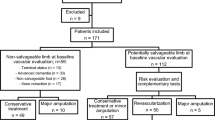Abstract
Purpose
This study was designed to study the outcome of infrainguinal revascularization in patients with critical limb ischemia (CLI) in an institution with a preference towards endovascular intervention first in patients with poor condition, unfavourable anatomy for surgery, no venous material for bypass, and old age.
Methods
A prospective, observational cohort study was conducted between May 2007 and May 2010 in patients presenting with CLI. At baseline, the optimal treatment was selected, i.e., endovascular or surgical treatment. In case of uncertainty about the preferred treatment, a multidisciplinary team (MDT) was consulted. Primary endpoints were quality of life and functional status 6 and 12 months after initial intervention, assessed by the VascuQol and AMC Linear Disability Score questionnaires, respectively.
Results
In total, 113 patients were included; 86 had an endovascular intervention and 27 had surgery. During follow-up, 41 % underwent an additional ipsilateral revascularisation procedure. For the total population, and endovascular and surgery subgroups, the VascuQol sum scores improved after 6 and 12 months (p < 0.01 for all outcomes) compared with baseline. The functional status improved (p = 0.043) after 12 months compared with baseline for the total population. Functional status of the surgery subgroup improved significantly after 6 (p = 0.031) and 12 (p = 0.044) months, but not that of the endovascular subgroup.
Conclusions
Overall, the strategy of performing endovascular treatment first in patients with poor condition, unfavourable anatomy for surgery, no venous material for bypass, and old age has comparable or even slightly better results compared with the BASIL trial and other cohort studies. All vascular groups should discuss whether their treatment strategy should be directed at treating CLI patients preferably endovascular first and consider implementing an MDT to optimize patient outcomes.



Similar content being viewed by others
References
Norgren L, Hiatt WR, Dormandy JA, Nehler MR, Harris KA, Fowkes FG (2007) Inter-Society Consensus for the Management of Peripheral Arterial Disease (TASC II). J Vasc Surg 45(Suppl S):S5–S67
Lawall H, Zemmrich C, Bramlage P, Amann B (2012) Health-related quality of life in patients with critical limb ischemia. Vasa 41(2):78–88
Forbes JF, Adam DJ, Bell J, Fowkes FG, Gillespie I, Raab GM et al (2010) Bypass versus Angioplasty in Severe Ischaemia of the Leg (BASIL) trial: health-related quality of life outcomes, resource utilization, and cost-effectiveness analysis. J Vasc Surg 51(5 Suppl):43S–51S
Bradbury AW, Adam DJ, Bell J, Forbes JF, Fowkes FG, Gillespie I et al (2010) Multicentre randomised controlled trial of the clinical and cost-effectiveness of a bypass-surgery-first versus a balloon-angioplasty-first revascularisation strategy for severe limb ischaemia due to infrainguinal disease. The Bypass versus Angioplasty in Severe Ischaemia of the Leg (BASIL) trial. Health Technol Assess 14(14):1–210
Met R, Reekers JA, Koelemay MJ, Legemate DA, de Haan RJ (2009) The AMC linear disability score (ALDS): a cross-sectional study with a new generic instrument to measure disability applied to patients with peripheral arterial disease. Health Qual Life Outcomes 7:88
Nordanstig J, Karlsson J, Pettersson M, Wann-Hansson C (2012) Psychometric properties of the disease-specific health-related quality of life instrument VascuQoL in a Swedish setting. Health Qual Life Outcomes. doi:10.1186/1477-7525-10-45
Morgan MB, Crayford T, Murrin B, Fraser SC (2001) Developing the Vascular Quality of Life Questionnaire: a new disease-specific quality of life measure for use in lower limb ischemia. J Vasc Surg 33(4):679–687
Holman R, Lindeboom R, Glas CA, Vermeulen M, de Haan MW (2003) Constructing an item bank using item response theory: the AMC Linear Disability Score project. Health Serv Outcomes Res Methodol 4:19–33
Frans FA, Met R, Koelemay MJ, Bipat S, Dijkgraaf MG, Legemate DA et al (2013) Changes in functional status after treatment of critical limb ischemia. J Vasc Surg 58(4):957–965
Adam DJ, Beard JD, Cleveland T, Bell J, Bradbury AW, Forbes JF et al (2005) Bypass versus angioplasty in severe ischaemia of the leg (BASIL): multicentre, randomised controlled trial. Lancet 366(9501):1925–1934
Soderstrom M, Aho PS, Lepantalo M, Alback A (2009) The influence of the characteristics of ischemic tissue lesions on ulcer healing time after infrainguinal bypass for critical leg ischemia. J Vasc Surg 49(4):932–937
Simons JP, Schanzer A, Nolan BW, Stone DH, Kalish JA, Cronenwett JL et al (2012) Outcomes and practice patterns in patients undergoing lower extremity bypass. J Vasc Surg 55(6):1629–1636
May KK, Robless PA, Sidhu HR, Chua BS, Ho P (2014) Limb salvage in patients with peripheral arterial disease managed by endovascular first approach. Vasc Endovascular Surg 48(2):129–133
Wakassa TB, Benabou JE, Puech-Leão P (2014) Clinical efficacy of successful angioplasty in critical ischemia. Ann Vasc Surg 28(5):1143–1148
Acknowledgments
Seino A. K. Jongkees (JSPS Postdoctoral fellow at Tokyo University, Tokyo Japan) provided linguistic revision of the article. A. P. Conijn and F. A. Frans were funded by the Dutch Organization for Health Research and Development (ZonMw Grant 171102025 [a government granting agency]).
Conflict of interest
S. Jens, A. P. Conijn, F. A. Frans, M. B. B. Nieuwenhuis, R. Met, M. J. W. Koelemay, D. A. Legemate, S. Bipat, J. A. Reekers have no conflict of interest.
Author information
Authors and Affiliations
Corresponding author
Electronic supplementary material
Below is the link to the electronic supplementary material.
Rights and permissions
About this article
Cite this article
Jens, S., Conijn, A.P., Frans, F.A. et al. Outcomes of Infrainguinal Revascularizations with Endovascular First Strategy in Critical Limb Ischemia. Cardiovasc Intervent Radiol 38, 552–559 (2015). https://doi.org/10.1007/s00270-014-0955-5
Received:
Accepted:
Published:
Issue Date:
DOI: https://doi.org/10.1007/s00270-014-0955-5




